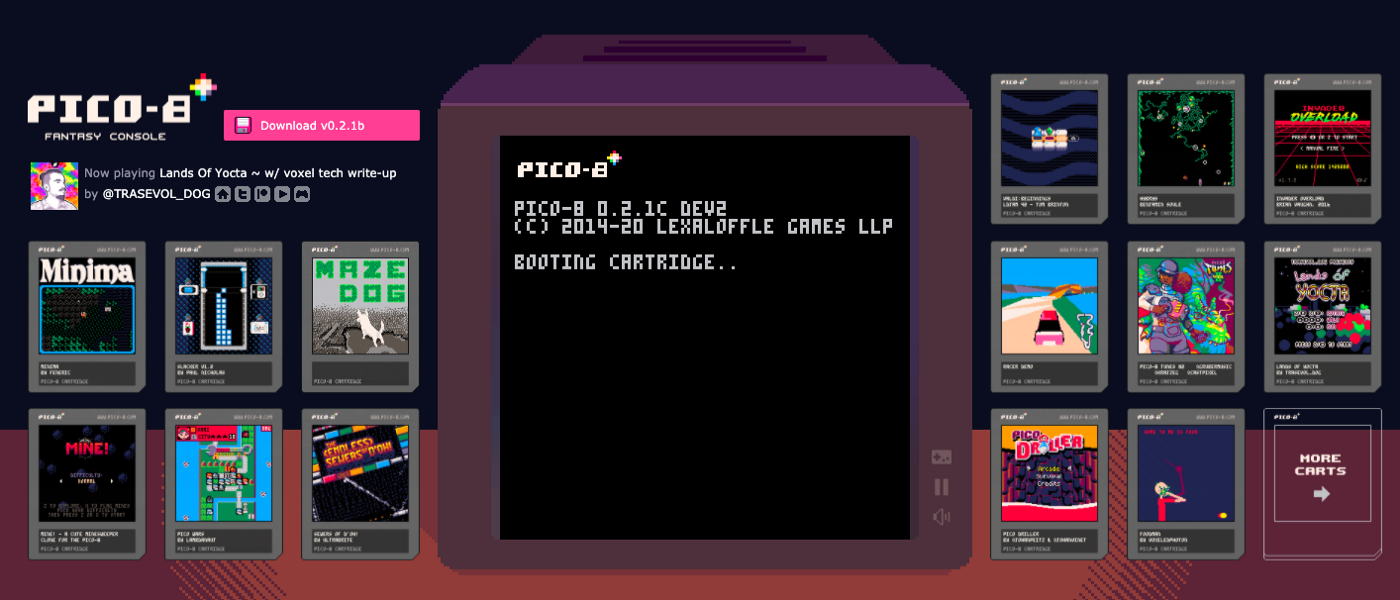Telling stories, working with technology, and creating visuals that carry a consistent aesthetic. These traits apply to most fields in marketing, but they apply to another exciting and rapidly changing field; game development. About a month ago, I came across a fantasy console called the PICO-8. You can deep dive into what makes fantasy consoles great or check out this handy comparison guide, but here’s a quick breakdown:
Fantasy Consoles are like any other console but there’s no physical hardware. Everything runs on your own computer without the need for additional peripherals (though there are some pretty cool pieces of hardware that can be used)
Intentionally designed, strict limitations which include lo-fi graphics (think original Nintendo Entertainment System), sound, music, and more.
In the case of PICO-8, all the tools you need to create a game are included in the fantasy console such as the programming shell, sprite editor, as well as music and SFX tools. Learn all about PICO-8 at lexaloffle.com.

I’ve always dreamt about building video games, but I wasn’t a coder and felt like I’d missed my opportunity to get involved. As games got more impressive, they also go much more complicated to build, and finding a place to start was daunting.
Then I found the PICO-8.
Through some great tutorials from a YouTube channel called Lazy Devs, I quickly caught the game dev bug. After getting started, I couldn’t believe how well aligned the core principles of game development and marketing were. The three things that drew me towards marketing were the alluring mixture of problem-solving, storytelling, and a dash of graphic design. Though I had always been a gamer, I never realized that these passions applied so readily to the field of video game development. This newfound passion led me to think about how my game dev hobby could help my marketing career.
Why Game Dev and Marketing are such a great fit
Problem-solving and storytelling are at the heart of game development and marketing. Although the problems being solved vary, finding creative solutions, using only the tools at your disposal, is paramount to any successful marketing campaign or game development journey.
When you are developing a marketing campaign, there are hundreds of tools and marketing tactics available for your consideration, but the key to a successful campaign is playing in the space that offers the most value to your customers and in return, your business. Likewise, the game you create doesn’t have to be earth-shattering, but it does have to speak to the appropriate audience. Sometimes an incredibly simple game can be quite fun to play. In fact, there is a great paper on cozy game design by Project Horseshoe.
Constraints, story-telling, programming, feedback, and community are the five areas where I’ve found the most overlap between game development and marketing. Looking at how these areas influence each other can help every marketer level up their skills.
Constraints

Whether it’s a limited budget, a limited staff, or just a limited amount of time, marketing departments are often faced with constraints that require intelligent planning to get the most out of every marketing campaign. Once you understand your constraints, the fun part begins; developing creative solutions to overcome them.
In marketing, this can involve optimizing messaging in your Google Ads or developing A/B testing email campaigns. What game development helped remind me is that you are going to get more out of your marketing if your constraints are well defined. Defined constraints provide a rigid framework for boundaries to be tested. Without them, it’s easy to dream up big, expensive marketing campaigns that will never see the light of day. It’s more difficult, and I would argue more fun, to work creatively within your constraints.
Although technology has gotten much better, even AAA game studios face constraints. Some constraints like budgets will feel familiar to any marketing professional, but there are also technological limitations that force creative thinking in game development. Even if you could program a game that mimicked real life, you’d need to sell your customers a bank of supercomputers so they could play it.
With fantasy consoles, the constraints are much more present and this forces you to think of better, more effective ways to tell your story and make something engaging. When you are forced to contemplate how to draw a forest landscape with a limited color palette or when you are running out of memory to handle all of your calculations you are forced to experiment with creative solutions that push the boundaries of what can be done. Clever color combinations can make a two-color landscape as visually appealing as a thirty-two color one. And finding ways to abstract your calculations can let a single function do the heavy lifting for many parts of your game.
Embracing your constraints is the easiest way to make the most out of your marketing department.
Story-telling
A stimulating story directs your audience's imagination while providing space for them to fill in the gaps. In marketing, a great story often points your customer's imagination to a world where your product solves the problem they have. A story that resonates can help any marketing campaign be more successful, but a great story doesn’t need to be complicated. In fact, when it comes to marketing, a simple story is often the most successful. Your customers don’t have a lot of time so it’s vital your story is simple enough to grasp quickly but interesting enough to keep your customer's attention.
Video games are many things, but being a vehicle for delivering a story may be the thing that truly keeps people coming back. Graphics get better, but the stories are what make games replayable.
There’s also been a heavy shift in gaming to the realm of playing online against other players. This shift drives a new form of story; the one that players create with other players. It takes the focus away from just the written story of the creators and shifts it onto the players.
Social media has precipitated a similar shift in marketing, removing full control over a brand’s messaging and handing it over to their customers. Brands that are successful in these realms have found the ability to become a facilitator of story-telling, the campfire if you will, where people come to create memories and share stories.
Programming
Like it or not, marketing has and will continue to be more driven by technology. This isn’t a bad thing and the more you understand about programming the more you’ll be able to take advantage of what programming can offer in improving your marketing campaigns.

The largest benefit of video game development, especially in cozy spaces like PICO-8, involves feedback (which we will cover shortly). Programming with PICO-8 gives you instantaneous feedback on whatever you are working on. You type your code, press run, and, if you’re lucky, you’ll see something on-screen that doesn’t include the word error. But, even if there is an error, it’s almost always made very obvious to you through the displayed message and you are able to get back in there and fix it.
I had tried to get into programming for many years. It was always a hobby I would pick up and then drop again. I’m not particularly fond of math and that seemed like an insurmountable obstacle. But with game development, programming became less abstract. You type in a quick command and you can make a pixel hop around the screen. Adjust the numbers and it does something a little different. The lag time between abstract math and tangible good is nearly zero.
As I become more comfortable programming with PICO-8, other programming problems that popped up around marketing were easier to solve because the line of thinking that made my game work can be applied to marketing solutions. An easy example is in setting up automated email drip campaigns. There are plenty of tools that make avoiding any direct programming a reality, but the mentality surrounding how/when emails should fire is helped immensely by embracing computational thinking.
Feedback

Marketing professionals know, or should know, the value of a great feedback loop. The gaming community is great for providing feedback (even when you don’t want to hear it). Gamers know what they want and are willing to tell you, but the key to gaining valuable insight from feedback is knowing how to listen to what is being said and determine what is useful to your goal.
When you are developing a game, there’s some game mechanic or general idea that gets you going. Maybe you drew a doodle of a character you think is really awesome, or you always thought it would be cool if you could move a character around on the moon and experience lower gravity. Whatever gets you started, it’s central to the game. Now, not everyone is going to think your character is awesome or that floating around on the moon is any fun. Although their feedback may be valid, it’s not really valuable to you and what you are trying to create. However, if someone says, “jumping on the moon just doesn’t feel right” or “the character really doesn’t fit the environment” these are worth taking a look and improving.
The same principle applies to marketing a business. There is a core value of the business or product you are marketing and that you are trying to show to other people. Let’s say you wanted to start a company like Tom’s. If someone tells you, “giving away a pair of shoes is a bad idea” that’s not very helpful to your mission. However, if a customer that tells you their “shoes fell apart after only a month.” or how “it would be great if there were more color options.” these are useful items of feedback.
Know your core value in whatever you create. Ignore feedback that cannot be used to improve on that core value.
Community
Community touches on every aspect of marketing and game development. It even applies as an umbrella across the areas previously discussed. But community has been so monumental to my journey, it needed its own section.
A great community can launch a brand from obscurity to prominence. Social media marketing is the most obvious place that this happens, but taking advantage of the platform is the real trick.
Game development has a huge community. PICO-8, in particular, has a thriving community of people on twitter, the lexaloffle BBS, and my favorite place to engage, their discord channel. Because of its approachability, PICO-8 brings together people of different backgrounds and abilities. There are people who have been making games their entire career, university and high school students with a passion for programming, and people like me.
Being involved in the game dev community has provided me with a few questions marketing professionals can ask about their own community building.
Why would anyone want to be a part of your community? What is the thing that would make people want to engage? Some brands have taken this to mean, being entertaining, like Wendy’s Twitter account. Other brands, like SpaceX, bring people together through a mission that’s bigger than the company.
Why are you using any particular platform? Sometimes you need to go where your customers are but sometimes you need to create the space for your customers to interact with you and each other.
Are you actually listening? If you are the only one talking you are not building a community. Yes, you need to be involved in the conversation, but more importantly, you need to take the lessons about feedback and listen.
A community that is ready to help other people on your behalf is a community that will prosper. What keeps me coming back to the PICO-8 discord is the people.
If INTEREST > 0 then START
By offering a singular place to develop your skills in working with constraints, story-telling, programming, listening to feedback, and building community, game development offers all marketing professionals a fun, engaging sphere to improve skills that are easily transferrable to their profession.
If you’re ready to level up your marketing skills through game dev, there are plenty of places to start. Fantasy consoles, like the PICO-8, are an attractive option because of their coziness, low cost, and active communities. But there are plenty of other options to get started, including:
Unity
Unreal
Game Maker Studio 2
RPG Maker
…and many many more
Good luck with your game development and marketing! I can’t wait to see what you create.
Below is a quick view of a very simple game I put together in PICO-8, you can play it for free here.
